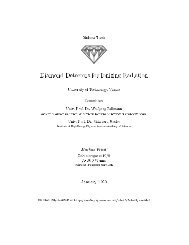You also want an ePaper? Increase the reach of your titles
YUMPU automatically turns print PDFs into web optimized ePapers that Google loves.
Figure 6.5: |η| distribution of non-isolated e/γ candidates in events from run 112265matching the L1 SingleEG5 algorithm.Since the trigger masks were configured to accept objects with a rank 1 ≥ 10 and theerror added 32 to the rank of all candidates, odd-η candidates of arbitrary rank wereaccepted. Figure 6.5 clearly shows the resulting skewed |η| distribution. Comparingthe recorded events with the emulator shows a large number of disagreements forelectron algorithms, see Fig. 6.6. Figure 6.7 shows the results of an interconnectiontest with the faulty board.6.2.3 Missing Muon “Mystery”The error described in the previous section was traced to a faulty connection on theGTL board, which was then replaced by a spare. A further analysis of the output fromthe data/emulator comparison revealed some disagreements in the muon algorithmsas well (see Fig. 6.8). The number of disagreements for single muon algorithms wassmall, but the double muon algorithm showed a much higher number of disagreements.Initially, this was puzzling since there were no known problems with the muon part ofthe system.At the time, the interconnection test as implemented in the TestCell did not yetexercise the muon inputs. When this functionality was added, it revealed that theentire MU3MU4 input of the GTL board consistently read as zero, regardless of theinputs sent from the GMT. Upon analysis of the board, this fault was traced to a1 The numerical value in the name of the trigger algorithm, L1 SingleEG5, refers to the e/γ E T ,which in this case was converted to hardware units with a linear scale of E T = rank/2 GeV.74












